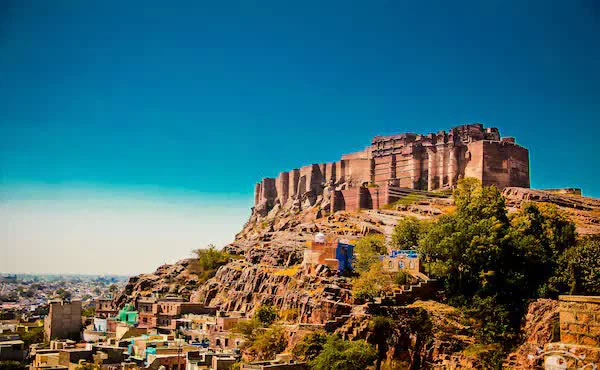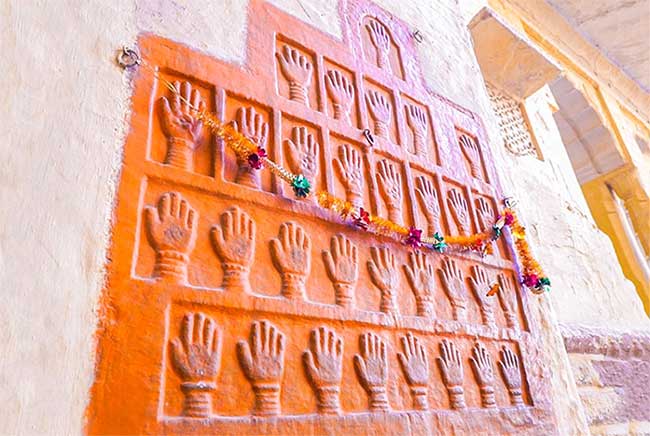The history of the handprints on the final gate of the castle can send shivers down the spine due to its brutality.
Rajasthan (India) is known as the “land of kings” because it has been home to 18 kings. In the western part of this region lies a city on the edge of the desert called Jodhpur, one of the three “blue cities” renowned worldwide. The most famous structure in this picturesque city is the “magnificent” fort known as Mehrangarh.
Mehrangarh Fort is perched on a steep hill 125 meters high in the center of Jodhpur. It was built in 1459 by Prince Gyudha and has a history spanning 560 years.
To make full use of the terrain, Lord Gyudha transformed the fort into a place that was easy to defend and hard to attack, carving the mountainside into a sheer cliff. The quarried stones were used to construct a towering wall, encasing the entire structure.
The fort, made of yellow sandstone, gives the impression that it has truly emerged from the mountain, while also serving its defensive purpose: easy to defend and hard to attack.

Close-up of Mehrangarh Fort. (Photo: MakeMyTrip).
To further fortify the structure, in the 19th century, Prince Malwa purchased a significant amount of artillery from Britain and placed it atop the towers to defend against foreign invaders, thus, Mehrangarh Fort was dubbed “impregnable.”
In addition to thick walls and densely arranged cannons, the fort features seven towering gates scattered from the base of the hill to the summit. The designer of the fort created numerous 180-degree turns to thwart advancing armies.
Long iron spikes, measuring several centimeters, were also positioned at the gates to deter approaching elephant troops.
Mehrangarh Fort has endured many wars throughout history, with the tower near the gate bearing marks of stone and arrow attacks. Some walls and gates also bear numerous “scars,” yet Mehrangarh has never fallen after countless sieges.

The “bloody handprints” on the iron gates of the fort. (Photo: Sohu).
Passing through the final iron gate of the fort, there are 31 “bloody handprints” on either side. Behind these handprints lies a profoundly brutal story.
In 1843, King Mansingh passed away. According to the customs of Hindus at that time, his wives were to be buried with him. Thus, on the day of the king’s cremation, 15 of his queens were also to participate in the burial ceremony for the living.
On that day, these queens needed to bathe in fragrant oils, dress beautifully, and paint their hands red to leave handprints on either side of the fort gate.
Ultimately, they sat on a flower-adorned seat surrounded by the people as they proceeded to the cremation pyre with the deceased king.
Subsequently, the Mughal dynasty issued a decree banning the use of living individuals as sacrificial offerings.
According to legend, these women, after death, would be venerated as the goddess Sati and worshipped.
Today, most of the palaces here have been transformed into displays of precious cultural artifacts. Inside, some valuable historical relics are showcased, including ancient Indian weapons, guns, royal thrones, and exquisite wall paintings.





















































